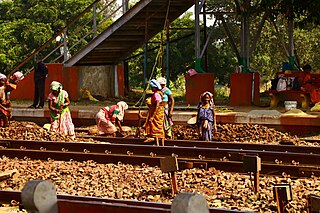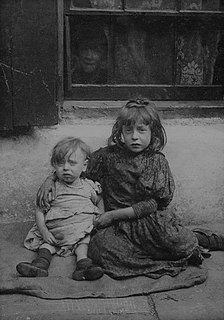
Unemployment, according to the OECD, is people above a specified age not being in paid employment or self-employment but currently available for work during the reference period.

In the economics study of the public sector, economic and social development is the process by which the economic well-being and quality of life of a nation, region, local community, or an individual are improved according to targeted goals and objectives.

The poverty threshold, poverty limit, poverty line or breadline is the minimum level of income deemed adequate in a particular country. The poverty line is usually calculated by estimating the total cost of one year's worth of necessities for the average adult. The cost of housing, such as the rent for an apartment, usually makes up the largest proportion of this estimate, so economists track the real estate market and other housing cost indicators as a major influence on the poverty line. Individual factors are often used to account for various circumstances, such as whether one is a parent, elderly, a child, married, etc. The poverty threshold may be adjusted annually. In practice, like the definition of poverty, the official or common understanding of the poverty line is significantly higher in developed countries than in developing countries.

Welfare, or commonly social welfare, is a type of government support intended to ensure that members of a society can meet basic human needs such as food and shelter. Social security may either be synonymous with welfare, or refer specifically to social insurance programs which provide support only to those who have previously contributed, as opposed to social assistance programs which provide support on the basis of need alone. The International Labour Organization defines social security as covering support for those in old age, support for the maintenance of children, medical treatment, parental and sick leave, unemployment and disability benefits, and support for sufferers of occupational injury.

The working poor are working people whose incomes fall below a given poverty line due to low-income jobs and low familial household income. These are people who spend at least 27 weeks in a year working or looking for employment, but remain under the poverty threshold.
Poverty in Australia deals with the incidence of relative poverty in Australia and its measurement. Relative income poverty is measured as a percentage of the population that earns less in comparison to the median wage of the working population.

Child poverty refers to the state of children living in poverty and applies to children from poor families and orphans being raised with limited or no state resources. UNICEF estimates that 356 million children live in extreme poverty. It's estimated that 1 billion children lack at least one essential necessity such as housing, regular food, or clean water. Children are more than twice as likely to live in poverty as adults and the poorest children are twice as likely to die before the age of 5 compared to their wealthier peers.

Poverty in the United Kingdom refers to the portion of the population of the United Kingdom that are considered to be in poverty under some measures of poverty.

Poverty in France has fallen by 60% over thirty years. Although it affected 15% of the population in 1970, in 2001 only 6.1% were below the poverty line.

The insider-outsider theory is a theory of labor economics that explains how firm behavior, national welfare, and wage negotiations are affected by a group in a more privileged position. The theory was developed by Assar Lindbeck and Dennis Snower in a series of publications beginning in 1984.
Asset poverty is an economic and social condition that is more persistent and prevalent than income poverty. It is a household’s inability to access wealth resources that are sufficient to provide for basic needs for a period of three months. Basic needs refer to the minimum standards for consumption and acceptable needs. Wealth resources consist of home ownership, other real estate, net value of farm and business assets, stocks, checking and savings accounts, and other savings. Wealth is measured in three forms: net worth, net worth minus home equity, and liquid assets. Net worth consists of all the aspects mentioned above. Net worth minus home equity is the same except it does not include home ownership in asset calculations. Liquid assets are resources that are readily available such as cash, checking and savings accounts, stocks, and other sources of savings. There are two types of assets: tangible and intangible. Tangible assets most closely resemble liquid assets in that they include stocks, bonds, property, natural resources, and hard assets not in the form of real estate. Intangible assets are simply the access to credit, social capital, cultural capital, political capital, and human capital.
Poverty in Canada refers to the state or condition in which a person or household lacks essential resources—financial or otherwise—to maintain a modest standard of living in their community.

In the United States, poverty has both social and political implications. In 2020, there were 37.2 million people in poverty. Some of the many causes include income inequality, inflation, unemployment, debt traps and poor education. The vast majority of people living in poverty are less educated and end up in a state of unemployment; higher incarceration rates have also been observed. Although the US is a relatively wealthy country by international standards, poverty has consistently been present throughout the United States, along with efforts to alleviate it, from New Deal-era legislation during the Great Depression, to the national war on poverty in the 1960s and poverty alleviation efforts during the 2008 Great Recession.
The European social model is a concept that emerged in the discussion of economic globalization and typically contrasts the degree of employment regulation and social protection in European countries to conditions in the United States. It is commonly cited in policy debates in the European Union, including by representatives of both labour unions and employers, to connote broadly "the conviction that economic progress and social progress are inseparable" and that "[c]ompetitiveness and solidarity have both been taken into account in building a successful Europe for the future".

Social protection, as defined by the United Nations Research Institute for Social Development, is concerned with preventing, managing, and overcoming situations that adversely affect people's well-being. Social protection consists of policies and programs designed to reduce poverty and vulnerability by promoting efficient labour markets, diminishing people's exposure to risks, and enhancing their capacity to manage economic and social risks, such as unemployment, exclusion, sickness, disability, and old age. It is one of the targets of the United Nations Sustainable Development Goal 10 aimed at promoting greater equality.
Welfare dependency is the state in which a person or household is reliant on government welfare benefits for their income for a prolonged period of time, and without which they would not be able to meet the expenses of daily living. The United States Department of Health and Human Services defines welfare dependency as the proportion of all individuals in families which receive more than 50 percent of their total annual income from Temporary Assistance for Needy Families (TANF), food stamps, and/or Supplemental Security Income (SSI) benefits. Typically viewed as a social problem, it has been the subject of major welfare reform efforts since the mid-20th century, primarily focused on trying to make recipients self-sufficient through paid work. While the term "welfare dependency" can be used pejoratively, for the purposes of this article it shall be used to indicate a particular situation of persistent poverty.

Poverty in Poland has been relatively stable in the past decades, affecting about 6.5% of the society. In the last decade there has been a lowering trend, as in general Polish society is becoming wealthier and the economy is enjoying one of the highest growth rates in Europe. There have been noticeable increases in poverty around the turns of the decades, offset by decreases in poverty in the years following those periods.
Poverty in Cyprus is not well documented, yet is still considered a major problem by the Cypriot government. Due to strong kinship bonds among extended families, poverty in Cyprus primarily affects those outside kinship networks, such as immigrants, divorcees and singles from small families. One study found a strong correlation between increased poverty and small family size. Poverty is also more likely to affect the elderly than the young, as a result of income to pensions raising the dependency levels.

Algeria is a country located in Africa along the Mediterranean coast. It is geographically the largest country in North Africa and has a population of approximately 42 million. Until the 1980s, Algeria enjoyed relative wealth after gaining independence from France in 1962 as its economy was buoyed by the booming price of oil. Poverty in Algeria became an acute problem following the collapse of its economic growth around the mid eighties. Since the 1980s, a fall in oil prices in international markets resulted in Algeria experiencing an economic downturn, contributing to rising unemployment and poverty. A lack of democracy, political conflict and government spending have also caused poverty.
Poverty in Norway had been declining from World War II until the Global Financial Crisis. It is now increasing slowly, and is significantly higher among immigrants from the Middle East and Africa. Before an analysis of poverty can be undertaken, the definition of poverty must first be established, because it is a subjective term. The measurement of poverty in Norway deviates from the measurement used by the OECD. Norway traditionally has been a global model and leader in maintaining low levels on poverty and providing a basic standard of living for even its poorest citizens. Norway combines a free market economy with the welfare model to ensure both high levels of income and wealth creation and equal distribution of this wealth. It has achieved unprecedented levels of economic development, equality and prosperity.












